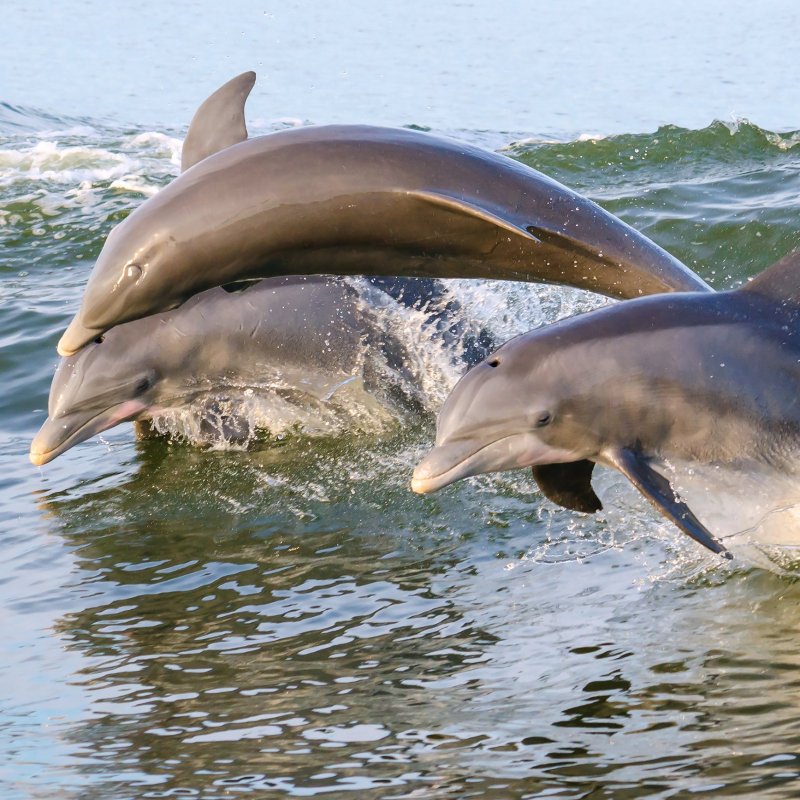
With 600 miles of tidal bay and bayou shoreline, Alabama’s Gulf Coast region is best known for the rolling tide that ebbs and flows along its sandy white coastline. And while the relaxing sound of the waves and the comfortably warm weather are the main draws for most snowbirds, the Yellowhammer State also offers the opportunity to observe critters that aren’t as common in other parts of the United States.
Videos by TravelAwaits
From dolphins frolicking in the bay to pelicans dive-bombing into the Gulf, here are a few animals to watch for along Alabama’s Gulf Coast.

Sage Scott
Alligators
When I think of the swampy marshland of the Gulf Coast region, the first animal that comes to mind is the alligator. With its lumbering gait and toothy crooked “smile,” this 600-pound reptile is synonymous with the American Southeast.
Although alligators are slow and clumsy on land, their powerful tails make them fast as lightning in the bodies of fresh water where they make their homes. So while enjoying the lakes, ponds, and rivers along Alabama’s Gulf Coast, be sure to keep an eye out for alligators. They typically hang out in groups (or congregations), so if you spot one gator, chances are there are others nearby.
For a sure shot at seeing alligators along Alabama’s Gulf Coast, stop by Alligator Alley. Located in Summerdale, Alabama, just west of the Baldwin Beach Express, Alligator Alley is home to more than 200 alligators ranging in size from hatchlings to adults.
Sea Turtles
Due to illegal poaching, fishing practices, beachside development, and changing climate, sea turtles are listed on the World Wildlife Fund’s endangered species list. But along Alabama’s Gulf Coast, from Orange Beach to Dauphin Island, volunteers at the sea turtle conservation program have helped more than 50,000 sea turtles hatch since 2003.
The best time to observe sea turtles is between July and October, about two months after female sea turtles have waddled ashore under the cover of darkness to dig 20-inch holes in the soft sand and discreetly deposit nests of eggs. When the eggs hatch, baby sea turtles emerge from just beneath the sand and make their way to the Gulf.
It’s important to note that both adult females and hatchlings are most active on the beaches at night, when they are less likely to be picked up by predators. This means that it may be difficult to spot sea turtles when you visit. However, early risers who enjoy walking along the beach might see the telltale tracks of mommas or babies who headed out to the water before the sun rose.
Pro Tip: Read and adhere to these rules to support nesting and hatching sea turtles.

Sage Scott
Bottlenose Dolphins
Several species of dolphins frolic in the Gulf of Mexico and surrounding bays, but the most common is the Atlantic bottlenose dolphin (like Flipper). Because bottlenose dolphins are fairly active during the day, you can spot them in the morning, afternoon, or evening. But to see these frisky marine mammals along Alabama’s Gulf Coast, you’ll have to get out on the water, so plan to take a dolphin cruise, jump on a jet ski, or hop on a paddleboard.
Pro Tip: If you prefer to watch for dolphins on dry land (perhaps with a Bushwacker in hand), it’s not uncommon to spot them from LuLu’s in Gulf Shores or Tacky Jacks in Orange Beach.
Blue Crabs
So named because of their lapis blue legs and pincers, blue crabs are some of the most common crustaceans you’ll see along Alabama’s Gulf Coast. They are typically found in the area’s back bays during the summer months, and one of the best ways to see them is to acquire a saltwater fishing license and go crabbing.
(Yes, a license is required — even if you plan to catch and release these crabby critters. There are exceptions for Alabama residents over the age of 65 and anyone under the age of 16.)

Brown Pelicans
It’s hard to spend time outside along Alabama’s Gulf Coast and not see a brown pelican gliding above the surf, keeping a watchful eye on the water below. And when he spots something that looks promising for dinner, he’ll dive-bomb into the water.
Hitting the water at full speed, he’ll fill his throat pouch with more than 2 gallons of water and small fish (like herring and anchovies) that live near the surface. As quickly as a chef separates an egg yolk from an egg white, he’ll drain the water from his pouch and let the fish slide down his throat and into his hungry belly. It’s quite a sight!
Stingrays
If you take to the water along Alabama’s Gulf Coast, one creature that you may not want to see is a stingray. After all, an Australian stingray was responsible for the tragic and untimely death of the Crocodile Hunter, Steve Irwin. But in coastal Alabama, the most common stingray is the cownose ray. With a face that resembles the velvet-like sniffer of a dairy cow, the cownose ray is constantly in motion, making it unlikely that you’ll step on it when swimming.
However, the region is also home to the southern stingray and the Atlantic stingray. Unlike the cownose ray, these cartilaginous creatures regularly burrow into the sandy bottom of the Gulf just a few yards from the shore. While stingrays aren’t aggressive predators, they will instinctively sting if disturbed. So, in order to avoid a trip to the hospital, be sure to shuffle your feet to let the rays know you’re coming when wading into the water along the Gulf of Mexico.
Pro Tip: Here’s what to do if you are stung by a stingray.
To see stingrays with zero risk of being stung, visit the Dauphin Island Sea Lab. Its 7,000-gallon stingray touch pool holds four species of stingrays and skates and is designed to allow visitors to pet the stingrays as they glide by.

Sage Scott
Monarch Butterflies
One of the most spectacular things to witness along Alabama’s Gulf Coast is the annual monarch butterfly migration. Thousands of black wings accented with pumpkin orange and marigold yellow fill the sky, resting on trees and refueling on wildflowers. Monarchs flutter through Alabama twice a year, in March and April when they travel north for the summer and again in September and October when they head south for the winter.
From delicate monarchs to monstrous alligators and from sapphire-colored crabs to silvery dolphins, there are plenty of neat animals to look for along Alabama’s Gulf Coast.
